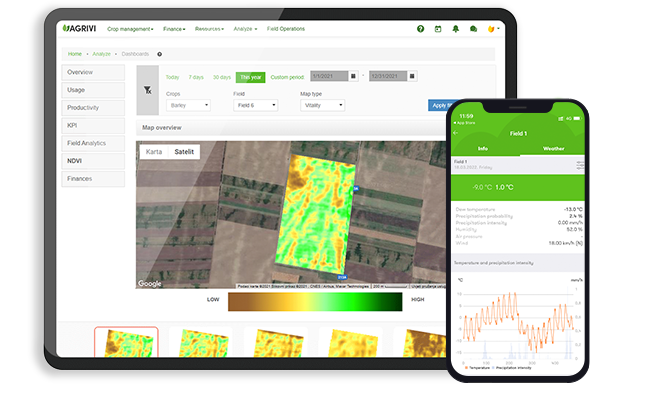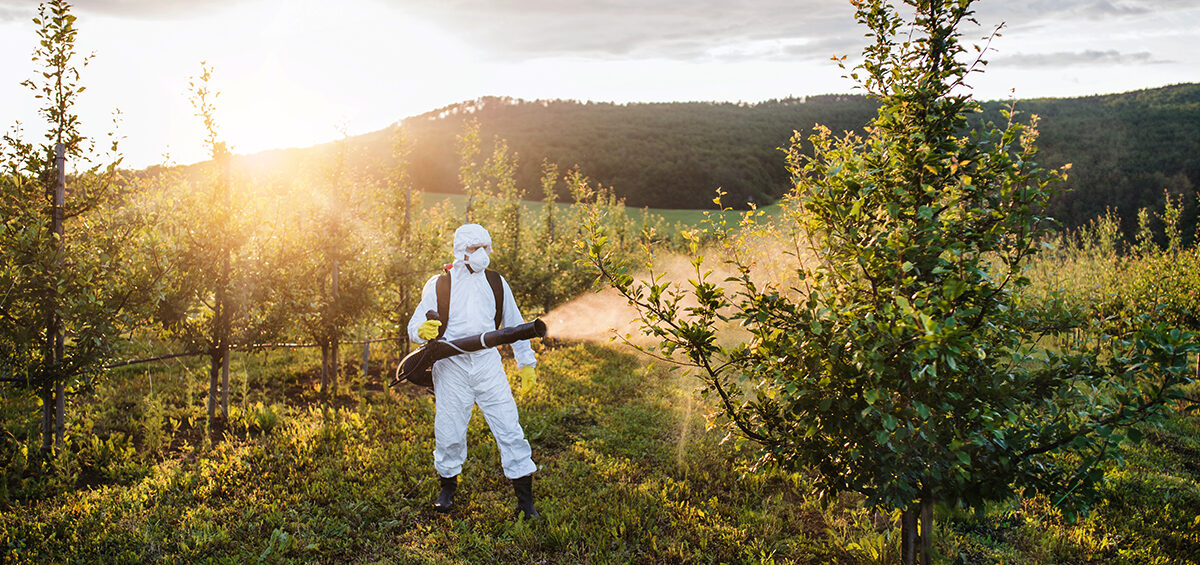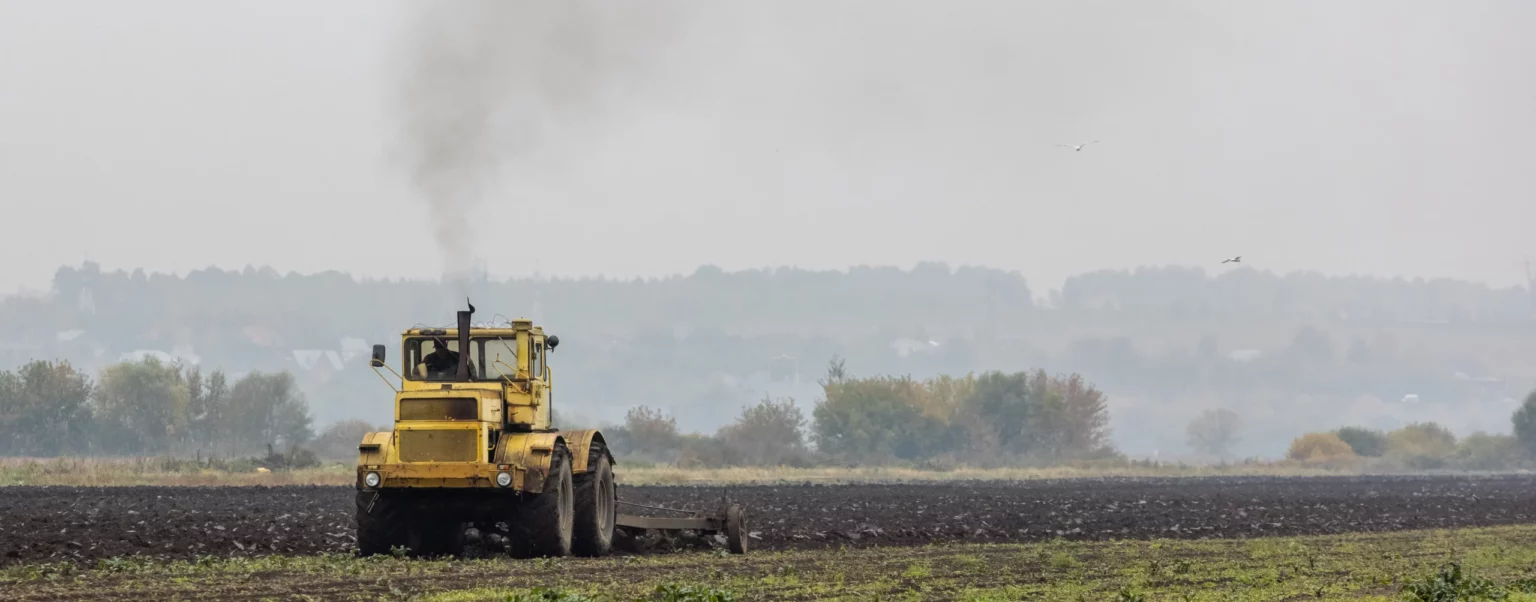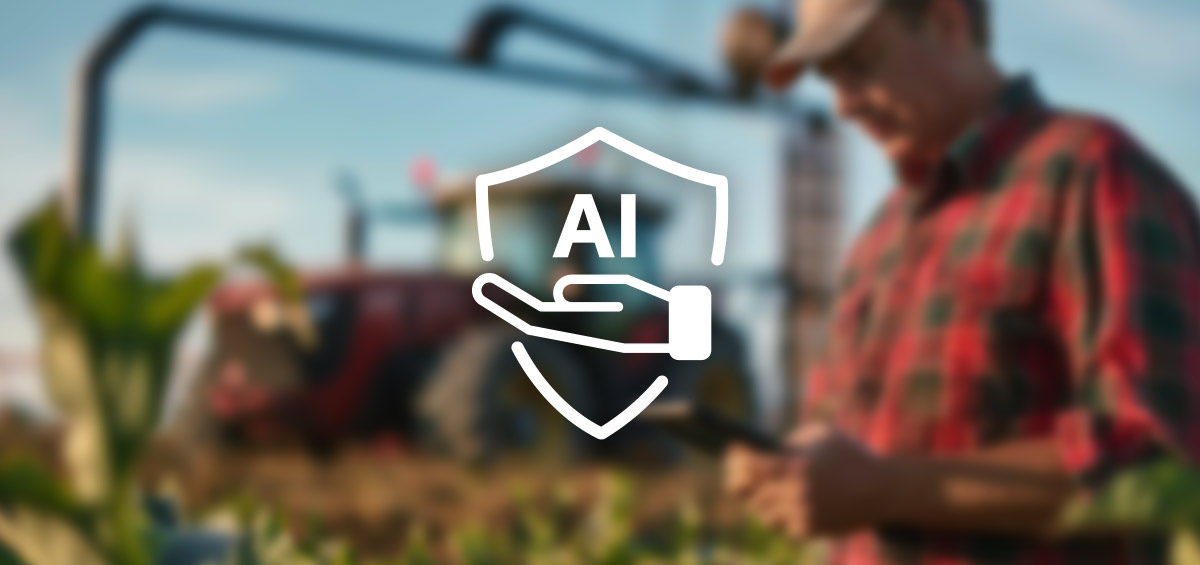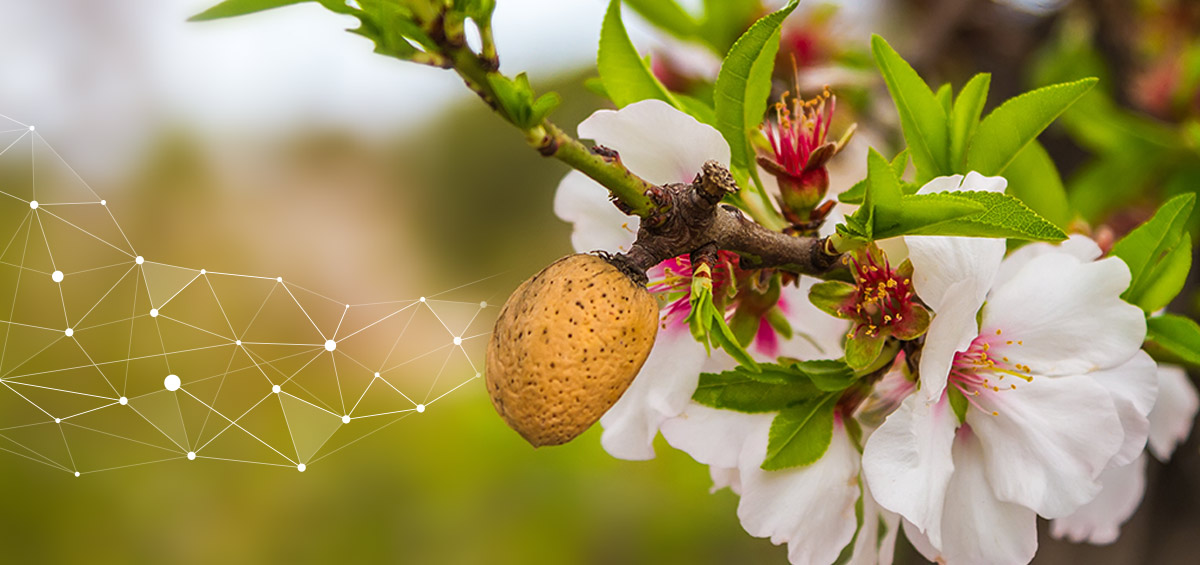Although farming is the backbone of civilization — powering our cars, nourishing our bodies, sustaining every aspect of our lives— the emergence of industrial agriculture has led to pollution on a widespread scale. For thousands of years, agriculture and ecosystems were held in balance: farmers passed down their land generation after generation, leaving ecosystems and soils intact.
But these farms were also more vulnerable to:
- Pest outbreaks
- Droughts
- Floods
- Disease
Modern agriculture has minimized many of these risks, but new problems have emerged: from pesticides to fertilizer runoff, from greenhouse gas emissions to harmful particulates, the inputs and by-products of modern agriculture can have unintended consequences for both ecosystems and humans. Fortunately, farm practices that prioritize sustainability can limit and even reverse the damage caused by environmental pollution.
Table of Contents
What Is Agricultural Pollution?
Agricultural pollution can be defined as contaminants in the environment that stem from crop production (biofuel, food crops, fiber crops, cash crops, etc.) and animal production.
Generally, pollutants are substances (including both chemicals and energy) that cause harm or discomfort to humans or other living organisms and that damage the environment.
Although pollutants can be naturally occurring, they are considered contaminants when in excess of natural levels. They can be further classified as:
- Point source pollution – originating from an easily definable source, such as a pipe emitting industrial waste
- Nonpoint source pollution – originating from many diffuse sources, the latter being most relevant to agriculture.
Agricultural pollution can be relatively innocuous—for example, the hum of a tractor can be considered noise pollution. Other types of agricultural pollution, however, can cause immense damage, with vast farm fields spanning thousands of acres contributing to problems such as eutrophication, climate change, biodiversity loss, and more.
Five Causes of Agricultural Pollution
- Pesticides and fertilizers – Modern inputs such as pesticides and fertilizers have undoubtedly transformed agriculture by minimizing crop damage and boosting yields, albeit temporarily. Once applied, pesticides such as insecticides, herbicides, and fungicides, as well as fertilizers rich in nutrients like phosphorus and nitrogen, do not disappear completely: some will be absorbed by the plant, while the rest must be processed by the environment. This can lead to runoff and groundwater contamination, drinking water contamination, air pollution through greenhouse gas emissions (e.g. nitrous oxide, carbon dioxide, methane, etc.), and cascading consequences for ecosystems and human health. Additionally, the production of these inputs requires the burning of fossil fuels, an energy-intensive practice that contributes to climate change.
- Contaminated water – Contaminated water used for irrigation is one further source of agricultural pollution. Much of the water used for irrigation comes from groundwater reservoirs, canals, and rainfall. And while plenty of these water resources is free of contaminants like nitrates and pesticides, other sources are polluted with organic compounds and heavy metals such as mercury, arsenic, lead, and cadmium that can contaminate soil resources and taint crops, as well as pathogens that can contribute to foodborne illness. This, of course, bears consequences for both ecosystem health and public health.
- Soil erosion and sedimentation – Soil is comprised of many layers, with the topmost serving to support farming and grazing. Due to poor land management practices, including excess and poorly-timed tillage, this valuable natural resource is vulnerable to erosion via wind and rain and declining fertility through the degradation of soil carbon (which in turn leads to the need for ever-increasing quantities of fertilizer and pesticides). Every year, millions of tons of soil are lost to erosion, with soil particulates entering waterways and contributing to sedimentation (a process in which particulate matter clouds waterways and blocks sunlight needed by aquatic plants, thereby damaging aquatic ecosystems).
- Livestock – Manure from livestock such as cattle, sheep, pigs, and chickens also contributes to both air pollution and water pollution. Concentrated Animal Feeding Operations (CAFO’s) are a major source of pollution due to the dense concentration of farm animals within a feedlot, as well as the scale of these operations, which generate millions of tons of manure every year. This waste is stored often stored in lagoons, contaminating groundwater with antibiotics, nutrients, and other harmful compounds.
- Pests and weeds – The introduction of non-native crops to new geographies through agricultural production systems often causes problems for local ecosystems. In the absence of natural predators, newly introduced species such as plants and insects often become invasive, leading to greater competition for important food and light resources among native species. Native species may also be more vulnerable to introduced pests and diseases, as they have not evolved defenses against these non-native organisms.
What Are the Effects of Agricultural Pollution on the Environment?
Reduction and alteration of wildlife habitats
Agricultural pollution can pose risks to ecosystems and thus important ecosystem services. Certain pesticides, for example, can harm a wide range of ecologically and economically important organisms, including pollinators, natural predators, birds, and microbial communities. For example, 35% of all food production relies on pollinators, which can be negatively impacted by direct contact with pesticides, as well as residues left on plants.
Once they make their way to waterways, fertilizers applied in excess have a particularly damaging effect on aquatic ecosystems. Excess nutrients in waterways spur the growth of “algal blooms,” which deplete the water of oxygen in a process known as eutrophication, thereby contributing to “dead zones” and “fish kills” (areas where aquatic life cannot survive due to the lack of oxygen).
Introduction of toxic chemicals, nutrients, and pathogens
As mentioned above, a number of agricultural inputs such as pesticides and fertilizers — not to mention antibiotics from animal production — make their way into drinking water, which can impact human health. Many of these pollutants are known carcinogens and are notoriously difficult to remove from tap water. From China to the United States, drinking water in many regions of the world is no longer potable due to agricultural pollution.
Invasive species
Invasive species introduced through agriculture can harm local vegetation and wildlife, altering ecosystems permanently. In some cases, when native species cannot adapt to novel diseases or introduced pests, or cannot compete with a new species that lack natural predators, they can face extinction – as was the case with the American chestnut, which was nearly wiped out due to a disease introduced by the Chinese chestnut.
Changes in the hydrologic cycle
Water pollution from agriculture can be intensified as a result of practices such as drainage tiling. Although tiling a farm field increases productivity, faster-draining fields reduce filtration, allowing larger amounts of fertilizers and pesticides to enter waterways and in turn worsening problems like eutrophication.
Climate change
Among the largest and most complex problems facing our world today, climate change includes not only global warming but also more frequent extreme weather events and shifting dynamics of diseases and pests — all of which affect agriculture profoundly. Agriculture itself is a large contributor to greenhouse gas emissions, which worsen climate change by accumulating in the atmosphere and trapping heat.
How Much Pollution Is Caused by Farming?
Although estimates vary, the US EPA reports that agriculture accounts for 24% of global greenhouse gas emissions, with animal agriculture representing 14.5 percent of GHG emissions. Additionally, agriculture is responsible for up to 78% of freshwater eutrophication and threatens 24,000 species with extinction due to pollution and habitat destruction.
How Can Farmers Reduce Their Environmental Impact?
There are a number of land management strategies farmers can adopt to reduce their environmental impact, improve air quality and water quality, and benefit ecosystems and public health.
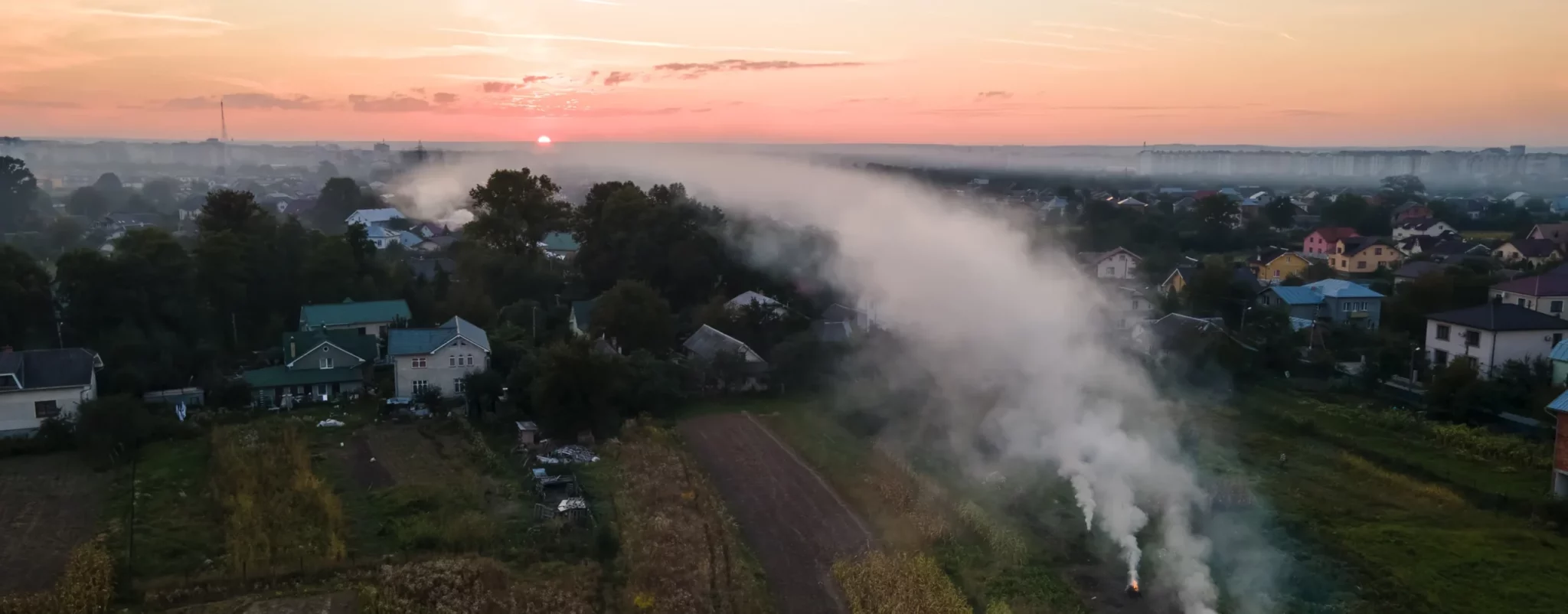
Agricultural waste bonfires from dry grass polluting air during the dry season have been linked to global warming and carcinogenic fumes in the air.
Cover Crops and Conservation Tillage
To reduce soil erosion on their fields, many farmers employ a strategy of conservation tillage, which refers to any tillage regime that leaves 30% of the soil surface covered with residue. By leaving residue on the soil surface, or by planting into residue from the previous crop, intense precipitation events are less likely to cause erosion and runoff, as the roots and vegetation from previous plantings serve as a buffer between the soil and the wind and rain.
Cover crops, which can be planted in many combinations across all seasons, work in tandem with conservation tillage to reduce erosion and improve soil quality. Cold season cover crops such as oats, vetch, and rye, as well as warm-season cover crops like sorghum-sudangrass and cowpeas, are planted during fallow periods so as to maintain ground cover, limit runoff, build soil organic matter, scavenge nutrients, and feed the soil microbiome. The benefits of cover crops and conservation tillage abound, and many incentive programs with the USDA and other government agencies compensate farmers for implementing these land-use strategies.
Buffer zones and habitat creation
Farmers may also plant “buffer zones,” or strategic areas of vegetation that fulfill a number of environmental functions, such as:
- Slowing agricultural runoff and erosion
- Increasing water filtration in high-risk areas (such as along a stream or in an important watershed)
- Reducing pesticide drift through windbreaks
- Creating habitat for native species, and more
Plants in these areas may be strategically selected based on their particular root structures, growth habits, absorptive qualities, or ecological roles. For example, “riparian” buffers are one specific buffer system that contains combinations of trees, shrubs, and perennials that improve stream quality and protect watersheds. The planting of buffer zones is likewise sponsored by government agencies like the EPA and USDA, often in partnership with local environmental organizations.
Manure management
Properly managing animal waste is among the many necessary steps farmers must take to reduce agricultural pollution. When applied to cropland in proper quantities at the correct time, manure can serve as an important source of organic matter and fertility, containing important nutrients such as nitrogen and phosphorus. In some areas, regional governments have begun adopting manure management policies and incentive programs to reduce nutrient loads on farms and protect important watersheds, with many regions like the Chesapeake Bay setting nutrient load limits for cropland.
Additionally, some farmers have begun employing “digesters” — novel technologies that convert methane from manure into electricity — thereby reducing the emissions footprint of farms.
Using AGRIVI to Combat Agricultural Pollution
Digital agricultural solutions such as AGRIVI are another important tool in improving both the productivity and sustainability of farms. Farm Management Software like AGRIVI allows farmers to not only track how much fertilizer and pesticides they apply, aggregating this data into readable reports for compliance, record keeping, and data analysis purposes, but also create prescription maps that adjust fertilizer and pesticide application rates based on real-time data about crop productivity, soil fertility, and plant health. Weather and pest alarms further allow farmers to time their spraying activities thus reducing costs incurred by repeating tasks unnecessarily. Using AGRIVI farms can take preventative actions to reduce pests, disease, and abiotic disorders before they become a problem in the first place.
